
What’s in Your Lunchbox?
Back on the farm in the 1950s, my mother brought out sandwiches and drinks to the fields so that we could make best use of the daylight to finish the plowing and disking. My favored sandwich was peanut butter, lettuce, and mayonnaise. Actually, the mayo was Miracle Whip, a slightly sweeter version, and the combination of the peanut butter and mayo was a great mix of sweet and tart together with the crunch of iceberg lettuce. Washed down with cold milk, it was just what I needed for fortification to continue plowing the back 40.
Worker lunches such as these became common in the Industrial Age as the pressures of factories and mills forced workers to eat a midday meal somewhere in the workplace. Most had no time to go home to eat, so they carried a convenient meal in a container to work. A cold lunch was the simplest solution, although street peddlers and saloons soon began filling the void. In the 1800s, oyster saloons were established to fill the meal gap. At some, women had their own dining area on the second floor. And in some areas, tea rooms catered to middle-class women. In New England, lunch wagons, then diners, became commonplace.
Boott Mill sandwich
In New England, according to a columnist in our local paper, the workers at the Boott Cotton Mill in Lowell, Massachusetts ate a midday sandwich that they named after the mill. The mill’s namesake was Boott, the first Agent of the Proprietors of Locks and Canals. Today, Boott Mill is part of the Lowell National Historic Park. The sandwich is a meal packed inside a bulky roll: egg topped with home fries, cheese, and your choice of corned beef hash, sausage, ham, or bacon. The meal is characteristic of the way that workers satisfied their midday hunger. Often, a worker’s lunch was composed of remnants of the previous night’s meal nestled between slices of bread. Those meals often became local culinary gems in their own right.
In north central West Virginia, Italian coal miners ate pepperoni on rolls; today, you can buy a pepperoni roll all across the mid-country Appalachian area. In Pittsburgh, steel workers ate a Pressanti Brothers, a sandwich created by a local 1930s restaurant by that name. The sandwich included meat, provolone cheese, thick-cut French fries, and a vinegar-based cole slaw, all stashed between two slices of Italian bread.
Cornish pasties
While touring the 1800s lead-mining town of Mineral Point, Wisconsin a few years ago, we learned that the Cornish immigrant miners took pasties in their lunch pails for a meal in the middle of their work shift. Composed of chunks of meat with thin slices of potato and other vegetables such as turnips and onion, it was wrapped in a dough made of flour and suet, folded into a “D” shape, crimped on one side, then baked. Indeed, we ordered pasties for lunch at a local Mineral Point diner.
As for the modern office world, we’ve pretty much left the three-martini and power lunches in the past, and today often settle for a sandwich at our workstation. But that still leaves me to wonder whether anybody is creating any new box-lunch specialties. What makes up your midday nourishment these days?



